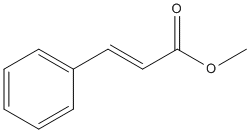Methyl-cinnamate
General
Type : Aryl ester
Chemical_Nomenclature : methyl (E)-3-phenylprop-2-enoate
Canonical SMILES : COC(=O)C=CC1=CC=CC=C1
InChI : InChI=1S\/C10H10O2\/c1-12-10(11)8-7-9-5-3-2-4-6-9\/h2-8H,1H3\/b8-7+
InChIKey : CCRCUPLGCSFEDV-BQYQJAHWSA-N
Other name(s) : Methyl cinnamate, 103-26-4, Methyl trans-cinnamate, Methyl (E)-cinnamate, 1754-62-7, Cinnamic acid methyl ester
MW : 162.18
Formula : C10H10O2
CAS_number :
PubChem :
UniChem :
Iuphar :

Target
Families : No family
References (3)
| Title : Fragrance material review on methyl cinnamate - Bhatia_2007_Food.Chem.Toxicol_45 Suppl 1_S113 |
| Author(s) : Bhatia SP , Wellington GA , Cocchiara J , Lalko J , Letizia CS , Api AM |
| Ref : Food & Chemical Toxicology , 45 Suppl 1 :S113 , 2007 |
| Abstract : Bhatia_2007_Food.Chem.Toxicol_45 Suppl 1_S113 |
| ESTHER : Bhatia_2007_Food.Chem.Toxicol_45 Suppl 1_S113 |
| PubMedSearch : Bhatia_2007_Food.Chem.Toxicol_45 Suppl 1_S113 |
| PubMedID: 18037211 |
| Title : Isolation and identification of mercapturic acid metabolites of phenyl substituted acrylate esters from urine of female rats - Delbressin_1982_Arch.Toxicol_49_321 |
| Author(s) : Delbressin LP , van Balen HC , Seutter-Berlage F |
| Ref : Archives of Toxicology , 49 :321 , 1982 |
| Abstract : Delbressin_1982_Arch.Toxicol_49_321 |
| ESTHER : Delbressin_1982_Arch.Toxicol_49_321 |
| PubMedSearch : Delbressin_1982_Arch.Toxicol_49_321 |
| PubMedID: 7092571 |